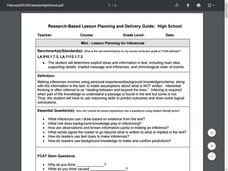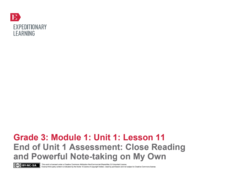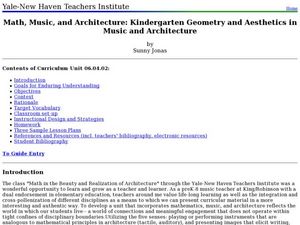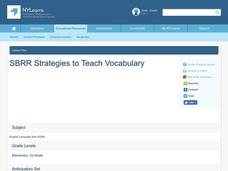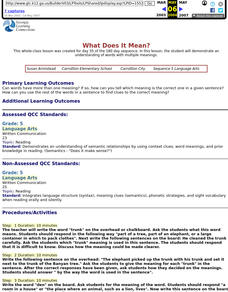Maine Content Literacy Project
Introduction to John Updike
Expand your pupils' understanding of the short story genre with a study of John Updike and his story "A&P." This lesson, the fourth in a series of fourteen, invites learners to examine literary terms and read and discuss the story....
Curated OER
Mini-Lesson Planning for Inferences
Making inferences and drawing conclusions is a key component to successful active reading. Encourage your class to use context clues and prior knowledge to infer different elements of a story, including the setting, plot, and character...
EngageNY
End of Unit 1 Assessment: Close Reading and Powerful Note-Taking on My Own
As the final lesson plan in a larger beginning-of-the-year unit to establish routines and teach close reading skills, this plan is designed as an assessment piece. Using the story, The Librarian of Basra, learners independently complete...
Curated OER
“THE LORAX” by Dr. Seuss
Few children's books convey the message of conservation as well as Dr. Seuss' The Lorax. Read the story aloud, emphasizing the interconnectedness of plants and animals in an ecosystem and discussing different ways people can help the...
Maine Content Literacy Project
Introduction to The Lottery, by Shirley Jackson
"The Lottery" by Shirley Jackson is a great story to share with your class, and this lesson focuses on just that story! The eighth in a fourteen-lesson series on short stories, the plan has learners study some vocabulary, read the story,...
EngageNY
An Appearance of Complex Numbers 1
Complex solutions are not always simple to find. In the fourth lesson of the unit, the class extends their understanding of complex numbers in order to solve and check the solutions to a rational equation presented in the first lesson....
Maine Content Literacy Project
Introduction to the Short Story
How should pupils read short stories? Set them up for this unit with an introductory instructional activity that goes over the main characteristics of a short story and starts learners off reading their first short story of the unit. In...
Curated OER
Non-Violence Means "Doing Nothing"
Students reflect on violence and non-violence. In this World History lesson, students read an article by Gandhi then write an essay as to whether they agree or disagree with his thoughts. Students then share all their ideas as a class.
Curated OER
Drama: Three Words
Seventh graders practice dramatic acting skills, using three words - why, oh, and sorry in different contexts. Working in groups of two or three, they create scenes in which the three words are the only ones spoken and are used to convey...
Curated OER
Using the News in Class
Students listen to international news stories. Students use context clues to determine the meaning of vocabulary words from context, then complete a matching exercise to see if their vocabulary definitions were correct. Students...
Curated OER
Somewhere Under the Rainbow--The Romantic Period in British Literature
Young scholars create 2-3 poems, a children's story, or a two or three dimensional piece of art. In this Romantic Period lesson, students discuss the historical background of the Romantic Period and relevant literary terms. Young...
Curated OER
African Slaves in Haiti
Sixth graders examine how Africans were treated in the Caribbean and Haiti after reading about the Atlantic Slave Trade. From a multicultural information passage, they complete a time line on Toussiant L-Ouverture and write an obituary.
Curated OER
Math, Music and Architecture: Kindergarten Geometry and Aesthetics in Music and Architecture
Students identify and name different geometrical shapes. In this math lesson, students distinguish odd from even numbers. They describe the properties of 2 and 3 dimensional objects.
Curated OER
SBRR Strategies to Teach Vocabulary
First graders use principles for learning useful, interesting and sophisticated words based on scientifically-based reading research. They expand their vocabulary knowledge of Tier 2 words through explicit, direct instruction.
Curated OER
Goldie Girl and There, Their, and They're: Homophones and Homographs
Instruct your class on homonyms and homophones. Learners take a pre-test and examine a list of homophones. They also play online word games to practice spelling and usage and write a fairy tale in which they use at least 10 homophones....
Curated OER
What Does It Mean?
Students demonstrate an understanding of words with multiple meanings. They give the meaning for each "trunk" in the sentence.
Curated OER
Introduce Vocabulary: Kindergarten ABC
Students explore vocabulary words. In this language arts lesson, students listen to the story Kindergarten ABC and discuss the vocabulary words. Students discuss the word meanings and use the word in context.
Curated OER
Defining Moments
Seventh graders use context clues to define words. In this language arts lesson plan, 7th graders engage in a class discussion regarding how we determine the meaning of words that we aren't familiar with. Then, students complete a very...
Curated OER
Practice With Week 2 Vocabulary
In this vocabulary worksheet, students learn the meanings and correct use of 10 words. Students complete ten assorted questions in which the words are used in context. Words seem unrelated.
Curated OER
Introduce Vocabulary: Giggle, Giggle, Quack
Students evaluate tier two vocabulary words. In this vocabulary instructional activity, students read Giggle, Giggle, Quack and determine the meaning of vocabulary words discovered in the story. Students record their learning in a word...
Curated OER
Mean, Median, and Mode
Eighth graders practice using the LIST key on graphing calculators using the proper syntax. They work with the functions of mean, median, and mode in a teacher led lesson and then with a partner on a second data set. They follow...
National Endowment for the Humanities
The Victor's Virtue: A Cultural History of Sport
Pupils explore the meaning of the ancient Greek word aretê and the place of virtue in historical athletic competition and modern sports. They begin by reading an informational text on the goal of sports in education, and then evaluate...
EngageNY
Using Linear Models in a Data Context
Practice using linear models to answer a question of interest. The 12th installment of a 16-part module combines many of the skills from previous lessons. It has scholars draw scatter plots and trend lines, develop linear models, and...
James Madison Memorial Fellowship Foundation
Those "Other Rights:" The Constitution and Slavery
Did the United States Constitution uphold the institution of slavery, or did it help to destroy it? Young historians study Article 4, Section 2, Clause 3 of the Constitution and evaluate the rights of slaveowners as they compared to or...



